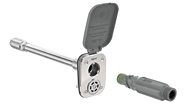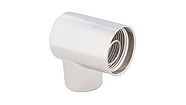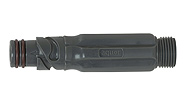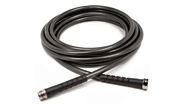
No more leaks and drips.
Unlike conventional brass hose bibs, the Aquor House Hydrant uses water pressure itself to keep the valve closed, guaranteeing a leak-free outlet.

No brass threads.
Forget the hassle of scraping your knees and knuckles trying to thread on garden hoses. Instead of dealing with compact threads that are a pain to use with cold or wet hands, the Aquor connection system is easy and convenient to use.

Never worry about freezing.
The stainless steel House Hydrant insulates your plumbing up to 7x better than brass “frost-free” sillcocks, so the hydrant does not need to be covered any further.
Typical brass plumbing fixtures are designed to meet low cost requirements and exhibit poor quality and construction.
With the House Hydrant, every aspect and material was examined to create the most robust valve design possible.
The original valve concept was engineered for use on marine vessels, and later adapted for homes.
The hydrant body is marine-grade 316L stainless steel, and is virtually indestructible. The internal seals are Viton® O-rings, commonly used in aerospace and automotive applications and renowned for their long lifetimes and resistance to wear. Aquor hose connectors are not plastic, but rather molded from a high-tech polymer called Delrin®.
How does a regular tap work?
Conventional brass sillcocks (also called hose bibs, or spigots) have a flawed sealing mechanism.

The friction of rotating and compressing a rubber washer onto a brass valve seat causes gradual wear. Over time, this unavoidable wear causes wasteful leaks and drips.
Most brass sillcocks are a single unit design, welded shut with no access to the valve seat. The washers and packing nuts can be replaced, but once the valve seat wears the entire unit must be scrapped. It is generally impossible to visually inspect the point where it seals.
What makes an Aquor valve different?
The Aquor® House Hydrant uses water pressure to keep its valve closed, rather than a screw-tightened assembly. This unique valve design seals with the exact same pressure and motion, every time. Unlike a conventional hose bib, the House Hydrant cannot be over-tightened by the user.

There is only one moving part: a solid stainless steel operating rod with a high performance Viton O-ring.
When you unplug from the hydrant, the valve closes in the same direction as water flow, not against it. The higher the water pressure, the tighter it seals.
Wait, it's always pressurized?
That’s right. The House Hydrant uses water pressure to keep its valve closed. A stainless steel spring helps keep the valve closed in case of loss of pressure.
How do I use it?
With the Aquor connector attached to your garden hose, simply walk up to the hydrant and plug in.
Water flow starts immediately when you connect, and stops instantly when you disconnect.
After you unplug, the hydrant self-drains automatically to prevent freezing.

Attach to Hose
Securely attach the Aquor connector to any garden hose.

Connect to Hydrant
Align the grooves, then swiftly push and turn clockwise to engage.

Disconnecting
Push the connector forward and turn counter-clockwise to disengage.

Storage
Always disconnect before freezing temperatures.
Why do we use stainless steel?
We use the same high-grade stainless steel alloy that is found in watches, kitchen appliances, and marine fittings. It’s durable, non-toxic, and rust-resistant. We think it looks pretty good, too.
Food grade.
It’s the same alloy used in many kitchen appliances and surgical tools. Absolutely no lead is used in our manufacturing process.
Better corrosion resistance.
We use 316L stainless steel, an extra-low-carbon alloy that is known as “marine-grade steel” due to its excellent durability and resistance to corrosion. To our knowledge, we are the only outdoor hydrant manufacturer in the world using true 316L stainless steel instead of brass.
Better freeze protection.
Stainless steel is also a much better insulator. Less thermal bridging to your plumbing means a significantly reduced chance of your pipes freezing (and bursting).
In fact, stainless steel is about 7x better than brass. The insulation is so good, you’ll probably never use a foam cover again.
What are Aquor hose connectors made of?
We use a heavy-duty acetal resin called Delrin.® It’s tough, wear-resistant, crush-proof, and stands up to UV rays.
We believe outdoor water should be easy to access, and never a hassle.
Connect garden hoses in less than a second.
Form meets function. Forget threading on garden hoses every time you need to access water outside. Just plug in the hose connector, and water turns on automatically. No pliers needed, no hassling trying to thread hoses on with wet hands.
When you’re done, unplug and go.
No hassles, no worries. As soon as you disconnect from the House Hydrant, your outlet automatically seals, drains, and winterizes. Never worry about uncovered hose bibs freezing in cold weather. No more leaks and drips means less water wasted.
No leaks. No maintenance. No worries.
Unlike brass spigots, the House Hydrant does not use a traditional screw-and-washer mechanism to seal. Aquor’s unique valve uses water pressure to close once the connector is unplugged. The result is a stronger, more reliable seal, even at high water pressures.
The resin is self-lubricating, and can withstand hundreds of thousands of cycles. While rugged, it’s lightweight enough to make carrying hoses easy, and won’t hurt anything (like your shins).







